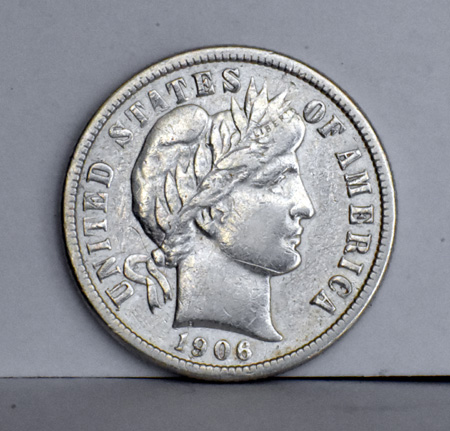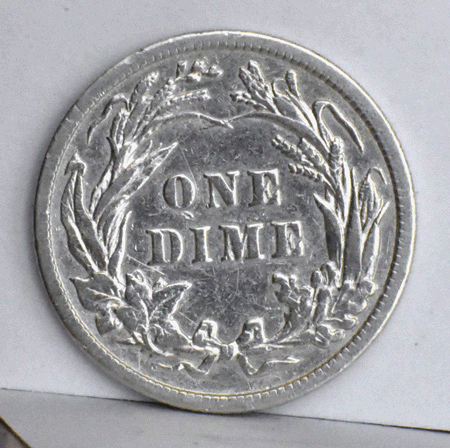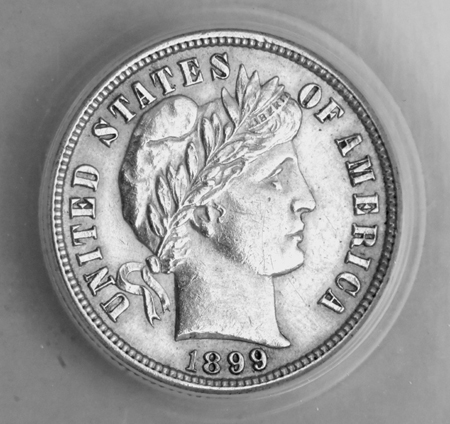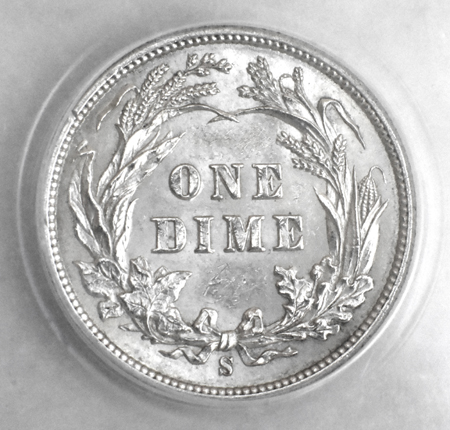Barber Dime
1892 to 1916
 |
In 1892 the Barber Dime (also called the Liberty Head Dime) was introduced. The designer was Charles E. Barber and his portrait of liberty found its way to the quarter and half as well. The reverse of the coin was left as it was on the earlier seated liberty design and the composition of the coin was the same as nearly all silver coins made by the U.S. Mint, about 90% silver and 10% copper. This coin remained virtually unchanged until 1916, except for two minor variations in 1893 and 1905, the 1893 example being a 3 over 2 strike which raised the value of this issue to a minimum of about $100. However, for reasons not explained in the literature, the 1894 dime was not minted in San Fransisco except for 24 specimens and this issue has thus become one of the rarest and most valuable coins in existence. In October, 2007, one sold at auction for $1,552,500. Currently, the 1895 O is the rarest Barber dime that is accessible to collectors, worth about $450 in Good condition. 440,000 minted. I currently have 76 Barber Dimes in my collection; an example of each of the different ones minted over the span of 24 years that they were minted. But only one of these is uncirculated because virtually all of those are valued at over $100 each these days. |
 |
| My example above is in VF condition and is worth about $20. I do have an 1895 O example that is certified to be a G 6 coin, which cost me $470 and is worth $525. My uncirculated issue is an 1899 S (below) which cost me $132.45 and is worth about $315. | Unfortunately, I have never imaged the 1895 O coin. | This is the reverse of the coin at left. And I have an 1898 coin in EF 45 grade that is stored in the D case. But most of the other issues in my collection are graded only AG 3 or G 4. |
 |
|
 |
This is the only uncirculated Barber dime that I own. It is an MS 60 coin, certified and slabbed, and stored in the red box. |
This is the reverse of the coin at left, showing the mint mark for San Francisco. |
1899: January 17: The United States takes possession of Wake Island. February 12–14: The Great Blizzard of 1899: Freezing temperatures and snow extend well south into North America, including southern Florida. It is the latest in a series of disasters to Florida's citrus industry. February 10: The Spanish–American War: The U.S. receives the Philippines, Samoa, Guam, and Puerto Rico as a result of the Treaty of Paris. February 14: Voting machines are approved by the U.S. Congress for use in federal elections. June 12: New Richmond Tornado: A tornado completely destroys the town of New Richmond, Wisconsin, killing 117 people and injuring more than 200. July 17: America's first juvenile court is established in Chicago. September 14: Henry H. Bliss becomes the first person to be killed by a motor vehicle in the United States. Upon disembarking from a streetcar in New York City, an electric-powered taxicab strikes and crushes him and he dies from his injuries the following morning. Date not known: Gold is discovered in Nome, Alaska. |
| 1906: January 8 – A landslide in Haverstraw, New York kills 21 people. April 18 – The 1906 San Francisco earthquake (estimated magnitude 7.8) on the San Andreas Fault destroys much of San Francisco, California, killing at least 3,000 people, with 225,000–300,000 left homeless, and $350,000,000 in damages. June 8 – Theodore Roosevelt signs the Antiquities Act into law, authorizing the President to restrict the use of certain parcels of public land with historical or conservation value. September 5 – Bradbury Robinson of St. Louis University throws the first legal forward pass in an American football game. September 24 – U.S. President Theodore Roosevelt proclaims Devils Tower, Wyoming as the nation's first National Monument. November 9 – U.S. President Theodore Roosevelt leaves for a trip to Panama to inspect the construction progress of the Panama Canal (the first time a sitting President of the United States makes an official trip outside of the United States). December 10 – U.S. President Theodore Roosevelt is awarded the Nobel Peace Prize for his role in negotiating peace in the Russo-Japanese War (1905). |